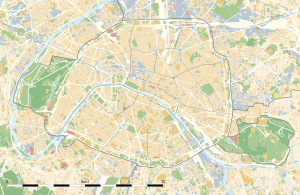
Back سراديب الموتى في باريس Arabic Катакомбы Парыжа Byelorussian Парижки катакомби Bulgarian Pariske katakombe BS Catacumbes de París Catalan Pařížské katakomby Czech Katakomberne i Paris Danish Katakomben von Paris German Κατακόμβες του Παρισιού Greek Katakomboj de Parizo Esperanto
This article needs additional citations for verification. (February 2024) |
Catacombes de Paris | |
 Crypt of the Sepulchral Lamp in the Catacombs of Paris | |
| Established | 1810 |
|---|---|
| Location | Place Denfert-Rochereau, 75014 Paris, France |
| Coordinates | 48°50′02″N 2°19′56″E / 48.83389°N 2.33222°E |
| Type | Historic site |
| Collections | Paris's former stone quarries, ossuary contents of Paris's pre-18th-century intra muros cemeteries |
| Visitors | 480,000 (2018)[1] |
| Public transit access | Denfert-Rochereau |
| Website | www |
The Catacombs of Paris (French: Catacombes de Paris, ⓘ) are underground ossuaries in Paris, France, which hold the remains of more than six million people.[2] Built to consolidate Paris's ancient stone quarries, they extend south from the Barrière d'Enfer ("Gate of Hell") former city gate; the ossuary was created as part of the effort to eliminate the effects of the city's overflowing cemeteries. Preparation work began shortly after a 1774 series of basement wall collapses around the Holy Innocents' Cemetery added a sense of urgency to the cemetery-eliminating measure, and from 1788, nightly processions of covered wagons transferred remains from most of Paris's cemeteries to a mine shaft opened near the Rue de la Tombe-Issoire .[3]
The ossuary remained largely forgotten until it became a novelty-place for concerts and other private events in the early 19th century; after further renovations and the construction of accesses around Place Denfert-Rochereau, it was opened to public visitation from 1874. Since 2013, the Catacombs have numbered among the fourteen City of Paris Museums managed by Paris Musées. Although the ossuary comprises only a small section of the underground mines of Paris, Parisians often refer to the entire tunnel network as the catacombs.
- ^ admin, Ecrit par (2019-02-18). "La fréquentation des musées et lieux de patrimoine en France, en 2018 (18/02/2019)". Club Innovation & Culture CLIC France (in French). Archived from the original on 2020-11-25. Retrieved 2019-06-12.
- ^ "Catacombs A Timeless Journey". Les Catacombes de Paris [Catacombs of Paris]. Archived from the original on 2015-02-08. Retrieved 2015-01-05.
- ^ Willsher, Kim (19 October 2024). "'Bodies were dropped down quarry shafts': secrets of millions buried in Paris catacombs come to light". The Guardian. Retrieved 27 October 2024.
